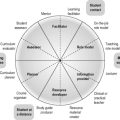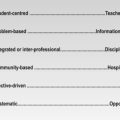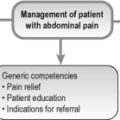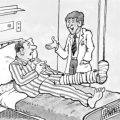19 Mapping the curriculum
Definition
A curriculum map is a visual representation of a curriculum that shows the big picture and how the different elements are related and linked together. It presents the curriculum as a sophisticated blend of educational strategies, course content, learning outcomes, educational experiences, assessment and programme of courses. It can even be thought of as the glue that holds the curriculum together. An example of part of a curriculum map through the window of learning outcomes is given in Figure 19.1.
Curriculum mapping is on today’s agenda
• Outcome-based education. The map makes explicit the expected learning outcomes for the different courses and learning experiences provided.
• Student-centred learning. The map of the curriculum helps students to take responsibility for their own learning, to appreciate what they are studying and the part it plays in the bigger picture, and how they can tailor the learning experiences to their personal needs.
• Problem-based and integrated learning. The map helps to clarify both the learning outcomes in PBL and integrated teaching programmes and the input from different disciplines.
• Inter-professional education. Common elements in the curriculum and the differences between medicine and other professions are described in a map. This facilitates the planning of inter-professional activities.
• Integration of assessment and teaching. The relationship between teaching and assessment is demonstrated in keeping with the move described in Section 5 towards ‘assessment for learning’.
• Distributed learning. A map helps to ensure uniformity in the curriculum where this is delivered by a medical school on two or more sites.
• Student mobility. The transparency of the learning programme implicit in a curriculum map allows students’ work to be recognised if they transfer to a different location. As envisaged in the Bologna process, a student may move on completion of the first cycle to complete the second cycle of their medical studies in another school.
• The continuum of education. A curriculum map assists the seamless transition between the different phases of undergraduate, postgraduate and continuing education and what is addressed in each phase.
• Curriculum evaluation. The curriculum map is of value for both internal and external assessment of the education programme including more formal accreditation and review by the public.
• Changes in medicine. A curriculum should be dynamic and not static in order that it can accommodate advances in medical practice. New subjects integrated into the curriculum are highlighted in the map. At the same time any redundancies and duplications in the curriculum can be recognised.
Potential users of the curriculum map
The curriculum map may be of value to:
• Teachers. The map provides an overview of the curriculum programme in its entirety so that teachers can appreciate the place of their course within the curriculum and identify their own roles and responsibilities. Students or trainees frequently complain that incorrect assumptions are made by staff about what topics are covered elsewhere in the curriculum.
• Curriculum planners. The map provides a tool to assist the planner to evaluate the curriculum and keep it up-to-date. The map can be used to study whether what it is assumed the students are learning (the ‘declared curriculum’), the curriculum that is presented (the ‘delivered curriculum’) and what students actually learn (the ‘learned curriculum’) are aligned.
• Students. The curriculum map together with the statement of expected learning outcomes and a study guide provide students with information that helps them to plan their programme of work and to assess their progress.
• Administrators and support staff. A curriculum map assists staff with the identification of resources necessary to implement the curriculum including staff, equipment and accommodation. It may also help to determine the contributions made by academic departments or individual members of staff to the curriculum and allow this to be recognised and rewarded.
• Accrediting bodies. The map may help to provide evidence that the medical school or postgraduate programme meets the expected requirements set out by accreditors.
• Educational researchers. There is a growing interest in research in medical education. The curriculum map is a useful tool for research into the existing curriculum or into changes made with regard to the teaching and assessment programme.
Preparing a curriculum map
Reflect and react
1. Think about how information relating to your curriculum is communicated to the students or trainees. To what extent is a map of the curriculum available that highlights for each part of the programme the learning outcomes, the learning opportunities and resources and the assessment procedures?
2. The investment of time necessary to map the curriculum can be rewarding and result in a much more powerful teaching and learning experience. Can you set some time aside to work on this?
Harden R.M. Curriculum mapping: a tool for transparent and authentic teaching and learning. AMEE Guide No. 21. Med. Teach.. 2001;23:123-137.
A description of curriculum mapping.
Ross N., Davies D. Outcome-based learning and the electronic curriculum at Birmingham Medical School. Med. Teach.. 1999;21:26-31.








